BULAW 5916 Taxation Law: Accounting Methods and Deductibility Report
VerifiedAdded on 2023/06/07
|12
|2834
|243
Report
AI Summary
This report provides a detailed analysis of accounting methods (cash vs. accrual) under taxation law, focusing on the factors influencing the choice of method and the rights of the Taxation Commissioner. It examines the case of Frank, a business owner, and advises on the appropriate accounting method for his situation, referencing relevant case law such as 'Carden v FC of T' and 'Henderson v FC of T'. The report also discusses the impact of accounting software on traditional methods. Furthermore, it delves into allowable deductions under the ITAA 1997, specifically addressing repairs, legal expenses, fines, business provisions, and preliminary expenses, using examples and case law such as 'BP Oil Refinery Ltd v FC of T' and 'Hallstorm Pty Ltd v FC of T' to support the analysis. The report concludes by determining the deductibility of various expenses incurred by Ruby Pty Ltd based on taxation rulings and legal precedents.

Running head: TAXATION LAW
Taxation Law
Name of the Student
Name of the University
Authors Note
Course ID
Taxation Law
Name of the Student
Name of the University
Authors Note
Course ID
Paraphrase This Document
Need a fresh take? Get an instant paraphrase of this document with our AI Paraphraser

1TAXATION LAW
Table of Contents
Answer to Part 1:........................................................................................................................2
Part 2:.........................................................................................................................................6
Answer to A:..............................................................................................................................6
Answer to B:..............................................................................................................................7
Answer to C:..............................................................................................................................8
Answer to D:..............................................................................................................................8
Answer to E:...............................................................................................................................9
References:...............................................................................................................................10
Table of Contents
Answer to Part 1:........................................................................................................................2
Part 2:.........................................................................................................................................6
Answer to A:..............................................................................................................................6
Answer to B:..............................................................................................................................7
Answer to C:..............................................................................................................................8
Answer to D:..............................................................................................................................8
Answer to E:...............................................................................................................................9
References:...............................................................................................................................10

2TAXATION LAW
Answer to Part 1:
There are two different ways of recording the accounting transactions namely the cash
basis and the accrual basis. The timing of recording the transactions forms the fundamental
underlying differences between the two methods. However, when it is combined over the
time, the results of the two methods yields the identical results. Under the cash basis of
accounting the recording of revenue is done when the cash is received and the outgoings are
recorded when the cash is paid to the suppliers and employees (Bushman et al., 2016).
Whereas, in the accrual basis the revenue is recorded when it is earned and the expenditure
are recorded when they are consumed. The cash basis of accounting is regarded as the easiest
method of accounting for the transactions as it does not involves any complex transactions.
While the accrual basis of accounting offers a business with long-term forecast that cash basis
of accounting fails to provide.
The law court in “Carden v FC of T (1938)” held that the method of tax accounting
should provide substantially the true and fair view of the taxpayer’s income (James, 2014).
While in “Henderson v FC of T (1970)” the court expressed its opinion by stating that for
any taxpayer there is only appropriate tax accounting method of determining the taxable
income.
Factors affecting the choice of cash or accrual basis of accounting:
There are few factors of determining whether the tax accounting method selected
provides the true reflect;
a. Size of the business
b. Proportion of business incomes that is directly originating from the taxpayer’s effort
c. Receivable of debt
d. Complication of enterprise
Answer to Part 1:
There are two different ways of recording the accounting transactions namely the cash
basis and the accrual basis. The timing of recording the transactions forms the fundamental
underlying differences between the two methods. However, when it is combined over the
time, the results of the two methods yields the identical results. Under the cash basis of
accounting the recording of revenue is done when the cash is received and the outgoings are
recorded when the cash is paid to the suppliers and employees (Bushman et al., 2016).
Whereas, in the accrual basis the revenue is recorded when it is earned and the expenditure
are recorded when they are consumed. The cash basis of accounting is regarded as the easiest
method of accounting for the transactions as it does not involves any complex transactions.
While the accrual basis of accounting offers a business with long-term forecast that cash basis
of accounting fails to provide.
The law court in “Carden v FC of T (1938)” held that the method of tax accounting
should provide substantially the true and fair view of the taxpayer’s income (James, 2014).
While in “Henderson v FC of T (1970)” the court expressed its opinion by stating that for
any taxpayer there is only appropriate tax accounting method of determining the taxable
income.
Factors affecting the choice of cash or accrual basis of accounting:
There are few factors of determining whether the tax accounting method selected
provides the true reflect;
a. Size of the business
b. Proportion of business incomes that is directly originating from the taxpayer’s effort
c. Receivable of debt
d. Complication of enterprise
⊘ This is a preview!⊘
Do you want full access?
Subscribe today to unlock all pages.

Trusted by 1+ million students worldwide
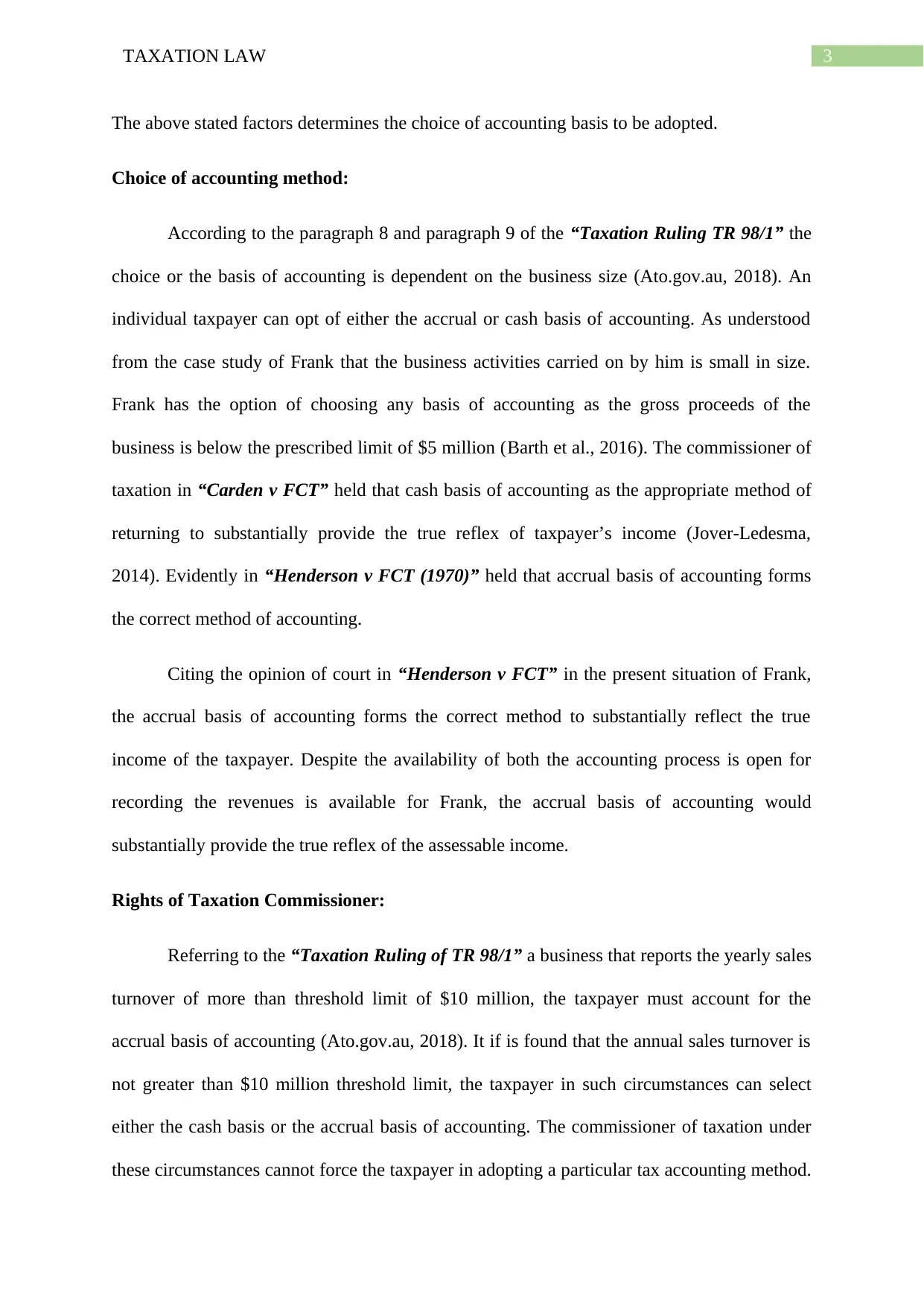
3TAXATION LAW
The above stated factors determines the choice of accounting basis to be adopted.
Choice of accounting method:
According to the paragraph 8 and paragraph 9 of the “Taxation Ruling TR 98/1” the
choice or the basis of accounting is dependent on the business size (Ato.gov.au, 2018). An
individual taxpayer can opt of either the accrual or cash basis of accounting. As understood
from the case study of Frank that the business activities carried on by him is small in size.
Frank has the option of choosing any basis of accounting as the gross proceeds of the
business is below the prescribed limit of $5 million (Barth et al., 2016). The commissioner of
taxation in “Carden v FCT” held that cash basis of accounting as the appropriate method of
returning to substantially provide the true reflex of taxpayer’s income (Jover-Ledesma,
2014). Evidently in “Henderson v FCT (1970)” held that accrual basis of accounting forms
the correct method of accounting.
Citing the opinion of court in “Henderson v FCT” in the present situation of Frank,
the accrual basis of accounting forms the correct method to substantially reflect the true
income of the taxpayer. Despite the availability of both the accounting process is open for
recording the revenues is available for Frank, the accrual basis of accounting would
substantially provide the true reflex of the assessable income.
Rights of Taxation Commissioner:
Referring to the “Taxation Ruling of TR 98/1” a business that reports the yearly sales
turnover of more than threshold limit of $10 million, the taxpayer must account for the
accrual basis of accounting (Ato.gov.au, 2018). It if is found that the annual sales turnover is
not greater than $10 million threshold limit, the taxpayer in such circumstances can select
either the cash basis or the accrual basis of accounting. The commissioner of taxation under
these circumstances cannot force the taxpayer in adopting a particular tax accounting method.
The above stated factors determines the choice of accounting basis to be adopted.
Choice of accounting method:
According to the paragraph 8 and paragraph 9 of the “Taxation Ruling TR 98/1” the
choice or the basis of accounting is dependent on the business size (Ato.gov.au, 2018). An
individual taxpayer can opt of either the accrual or cash basis of accounting. As understood
from the case study of Frank that the business activities carried on by him is small in size.
Frank has the option of choosing any basis of accounting as the gross proceeds of the
business is below the prescribed limit of $5 million (Barth et al., 2016). The commissioner of
taxation in “Carden v FCT” held that cash basis of accounting as the appropriate method of
returning to substantially provide the true reflex of taxpayer’s income (Jover-Ledesma,
2014). Evidently in “Henderson v FCT (1970)” held that accrual basis of accounting forms
the correct method of accounting.
Citing the opinion of court in “Henderson v FCT” in the present situation of Frank,
the accrual basis of accounting forms the correct method to substantially reflect the true
income of the taxpayer. Despite the availability of both the accounting process is open for
recording the revenues is available for Frank, the accrual basis of accounting would
substantially provide the true reflex of the assessable income.
Rights of Taxation Commissioner:
Referring to the “Taxation Ruling of TR 98/1” a business that reports the yearly sales
turnover of more than threshold limit of $10 million, the taxpayer must account for the
accrual basis of accounting (Ato.gov.au, 2018). It if is found that the annual sales turnover is
not greater than $10 million threshold limit, the taxpayer in such circumstances can select
either the cash basis or the accrual basis of accounting. The commissioner of taxation under
these circumstances cannot force the taxpayer in adopting a particular tax accounting method.
Paraphrase This Document
Need a fresh take? Get an instant paraphrase of this document with our AI Paraphraser
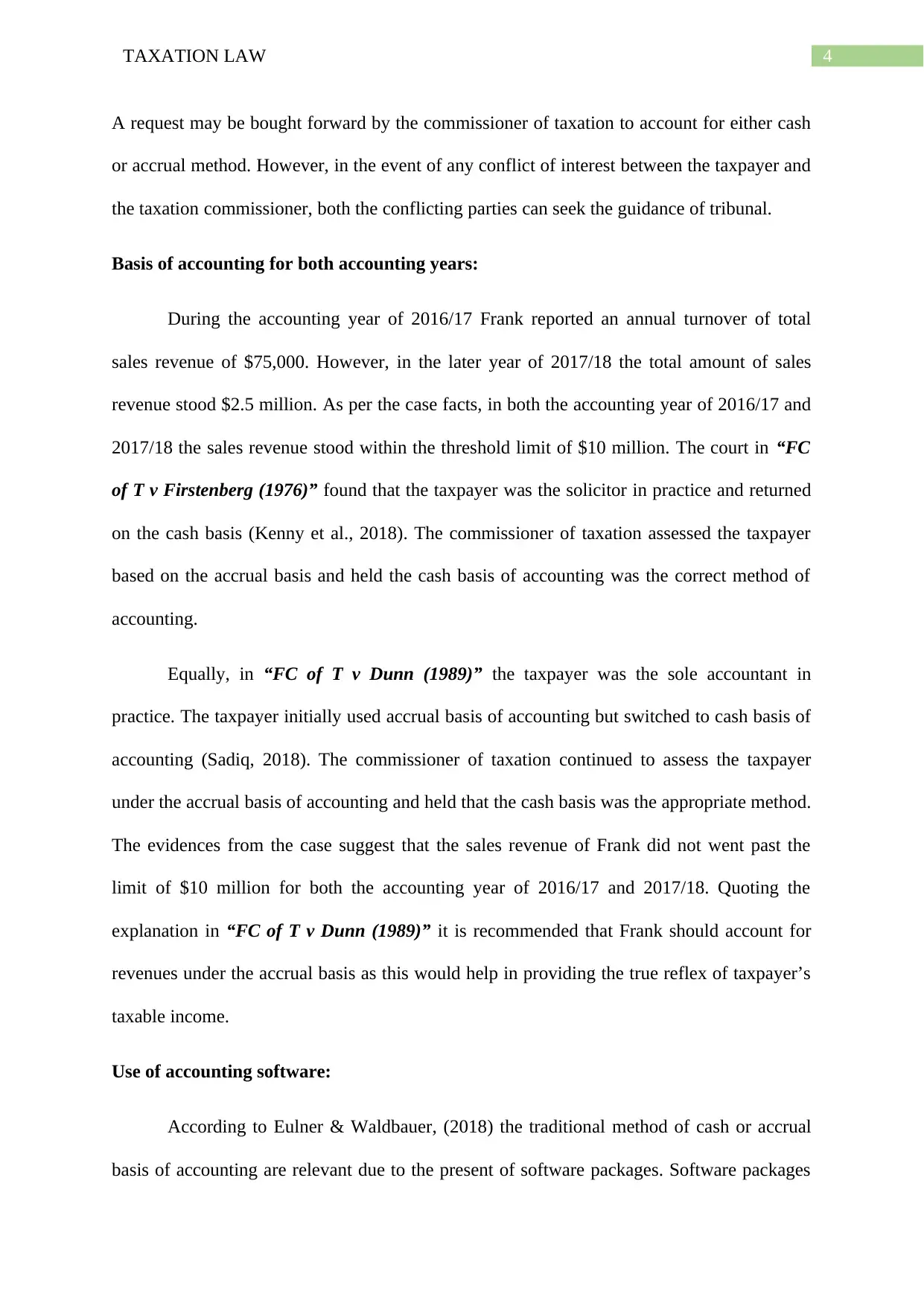
4TAXATION LAW
A request may be bought forward by the commissioner of taxation to account for either cash
or accrual method. However, in the event of any conflict of interest between the taxpayer and
the taxation commissioner, both the conflicting parties can seek the guidance of tribunal.
Basis of accounting for both accounting years:
During the accounting year of 2016/17 Frank reported an annual turnover of total
sales revenue of $75,000. However, in the later year of 2017/18 the total amount of sales
revenue stood $2.5 million. As per the case facts, in both the accounting year of 2016/17 and
2017/18 the sales revenue stood within the threshold limit of $10 million. The court in “FC
of T v Firstenberg (1976)” found that the taxpayer was the solicitor in practice and returned
on the cash basis (Kenny et al., 2018). The commissioner of taxation assessed the taxpayer
based on the accrual basis and held the cash basis of accounting was the correct method of
accounting.
Equally, in “FC of T v Dunn (1989)” the taxpayer was the sole accountant in
practice. The taxpayer initially used accrual basis of accounting but switched to cash basis of
accounting (Sadiq, 2018). The commissioner of taxation continued to assess the taxpayer
under the accrual basis of accounting and held that the cash basis was the appropriate method.
The evidences from the case suggest that the sales revenue of Frank did not went past the
limit of $10 million for both the accounting year of 2016/17 and 2017/18. Quoting the
explanation in “FC of T v Dunn (1989)” it is recommended that Frank should account for
revenues under the accrual basis as this would help in providing the true reflex of taxpayer’s
taxable income.
Use of accounting software:
According to Eulner & Waldbauer, (2018) the traditional method of cash or accrual
basis of accounting are relevant due to the present of software packages. Software packages
A request may be bought forward by the commissioner of taxation to account for either cash
or accrual method. However, in the event of any conflict of interest between the taxpayer and
the taxation commissioner, both the conflicting parties can seek the guidance of tribunal.
Basis of accounting for both accounting years:
During the accounting year of 2016/17 Frank reported an annual turnover of total
sales revenue of $75,000. However, in the later year of 2017/18 the total amount of sales
revenue stood $2.5 million. As per the case facts, in both the accounting year of 2016/17 and
2017/18 the sales revenue stood within the threshold limit of $10 million. The court in “FC
of T v Firstenberg (1976)” found that the taxpayer was the solicitor in practice and returned
on the cash basis (Kenny et al., 2018). The commissioner of taxation assessed the taxpayer
based on the accrual basis and held the cash basis of accounting was the correct method of
accounting.
Equally, in “FC of T v Dunn (1989)” the taxpayer was the sole accountant in
practice. The taxpayer initially used accrual basis of accounting but switched to cash basis of
accounting (Sadiq, 2018). The commissioner of taxation continued to assess the taxpayer
under the accrual basis of accounting and held that the cash basis was the appropriate method.
The evidences from the case suggest that the sales revenue of Frank did not went past the
limit of $10 million for both the accounting year of 2016/17 and 2017/18. Quoting the
explanation in “FC of T v Dunn (1989)” it is recommended that Frank should account for
revenues under the accrual basis as this would help in providing the true reflex of taxpayer’s
taxable income.
Use of accounting software:
According to Eulner & Waldbauer, (2018) the traditional method of cash or accrual
basis of accounting are relevant due to the present of software packages. Software packages
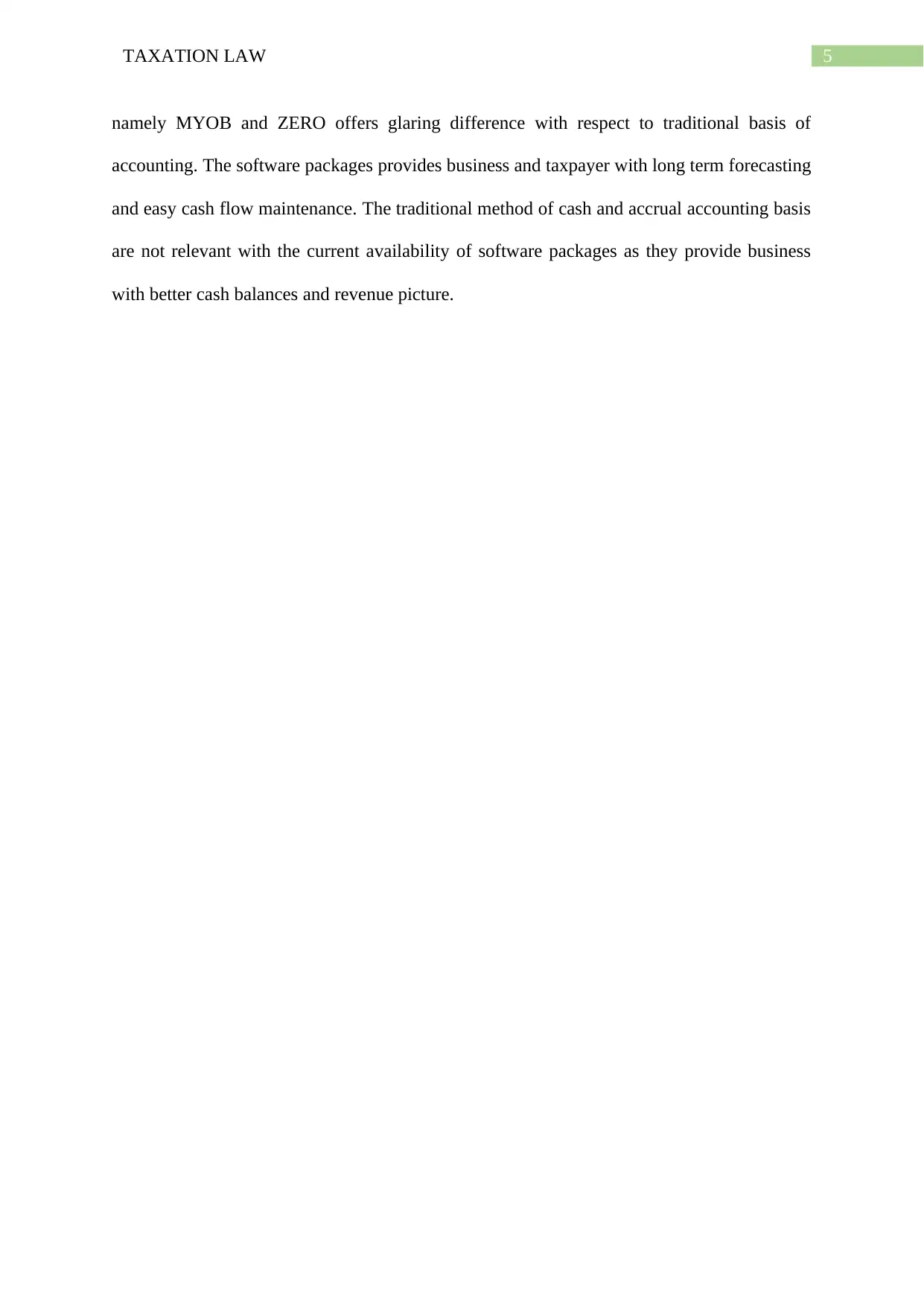
5TAXATION LAW
namely MYOB and ZERO offers glaring difference with respect to traditional basis of
accounting. The software packages provides business and taxpayer with long term forecasting
and easy cash flow maintenance. The traditional method of cash and accrual accounting basis
are not relevant with the current availability of software packages as they provide business
with better cash balances and revenue picture.
namely MYOB and ZERO offers glaring difference with respect to traditional basis of
accounting. The software packages provides business and taxpayer with long term forecasting
and easy cash flow maintenance. The traditional method of cash and accrual accounting basis
are not relevant with the current availability of software packages as they provide business
with better cash balances and revenue picture.
⊘ This is a preview!⊘
Do you want full access?
Subscribe today to unlock all pages.

Trusted by 1+ million students worldwide

6TAXATION LAW
Part 2:
Answer to A:
As per the “taxation ruling of TR 98/23” the term repair has the ordinary meaning.
With reference to “section 25-10 of the ITAA 1997” the term repair refers to the work done
on the premises or articles (Woellner et al., 2018). Repair ordinarily implies remedying the
defects due to damage, deterioration of the property and considers the constant presence of
the property. Repairs for majority part of the property is held as occasional and partial. It
comprises of the restoration of the efficiency function of the property that is being repaired
without changing any of its characteristics and might provide an indication of the restoration
to its previous appearance, form or condition.
Works can be fairly labelled as repair if they are done to make the damage good or
deterioration that has taken place because of the ordinary wear and tear. An opinion was
expressed by court in “BP Oil Refinery Ltd v FC of T (1992)” by stating that a work cannot
be regarded as repair until some work of restoration is performed (Douglas et al., 2014).
In the current situation Ruby Pty Ltd owned a residence property from 2008. The
company incurred expenses on replacing the old kitchen fittings and cupboard which was
deteriorated by wear and tear. Referring to the court opinion in “BP Oil Refinery Ltd v FC of
T (1992)” the cost of replacing the kitchen fittings and cupboard constitute repair arising out
of wear and tear (Blakelock & King, 2017). Replacing of kitchen fittings and cupboard
represents restoration of the efficiency of the rental property without changing its character.
Ruby Pty Ltd under “section 25-10 of the ITAA 1997” would be allowed to claim an
allowable deduction for expenses on repair of fittings and cupboards.
Part 2:
Answer to A:
As per the “taxation ruling of TR 98/23” the term repair has the ordinary meaning.
With reference to “section 25-10 of the ITAA 1997” the term repair refers to the work done
on the premises or articles (Woellner et al., 2018). Repair ordinarily implies remedying the
defects due to damage, deterioration of the property and considers the constant presence of
the property. Repairs for majority part of the property is held as occasional and partial. It
comprises of the restoration of the efficiency function of the property that is being repaired
without changing any of its characteristics and might provide an indication of the restoration
to its previous appearance, form or condition.
Works can be fairly labelled as repair if they are done to make the damage good or
deterioration that has taken place because of the ordinary wear and tear. An opinion was
expressed by court in “BP Oil Refinery Ltd v FC of T (1992)” by stating that a work cannot
be regarded as repair until some work of restoration is performed (Douglas et al., 2014).
In the current situation Ruby Pty Ltd owned a residence property from 2008. The
company incurred expenses on replacing the old kitchen fittings and cupboard which was
deteriorated by wear and tear. Referring to the court opinion in “BP Oil Refinery Ltd v FC of
T (1992)” the cost of replacing the kitchen fittings and cupboard constitute repair arising out
of wear and tear (Blakelock & King, 2017). Replacing of kitchen fittings and cupboard
represents restoration of the efficiency of the rental property without changing its character.
Ruby Pty Ltd under “section 25-10 of the ITAA 1997” would be allowed to claim an
allowable deduction for expenses on repair of fittings and cupboards.
Paraphrase This Document
Need a fresh take? Get an instant paraphrase of this document with our AI Paraphraser
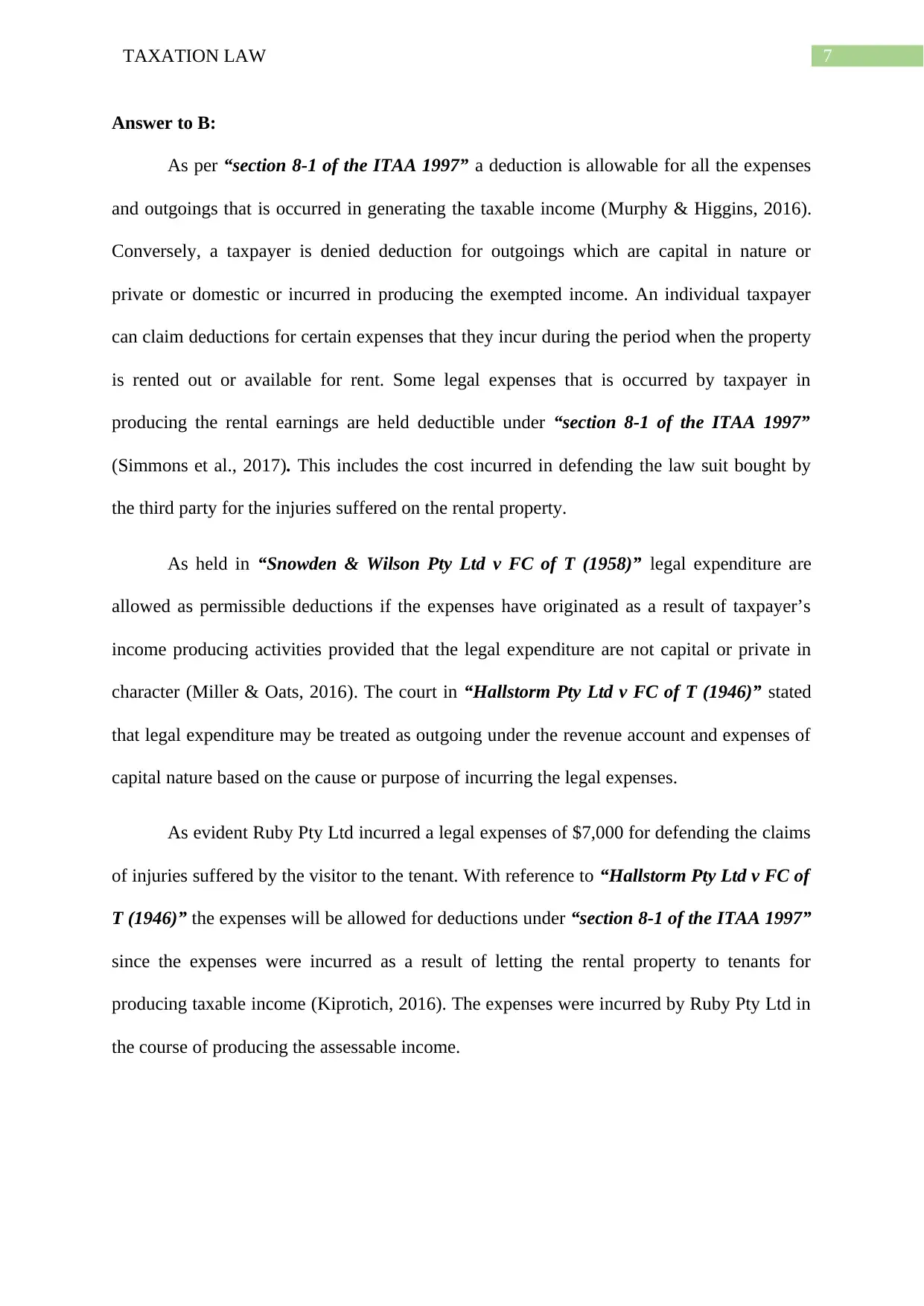
7TAXATION LAW
Answer to B:
As per “section 8-1 of the ITAA 1997” a deduction is allowable for all the expenses
and outgoings that is occurred in generating the taxable income (Murphy & Higgins, 2016).
Conversely, a taxpayer is denied deduction for outgoings which are capital in nature or
private or domestic or incurred in producing the exempted income. An individual taxpayer
can claim deductions for certain expenses that they incur during the period when the property
is rented out or available for rent. Some legal expenses that is occurred by taxpayer in
producing the rental earnings are held deductible under “section 8-1 of the ITAA 1997”
(Simmons et al., 2017). This includes the cost incurred in defending the law suit bought by
the third party for the injuries suffered on the rental property.
As held in “Snowden & Wilson Pty Ltd v FC of T (1958)” legal expenditure are
allowed as permissible deductions if the expenses have originated as a result of taxpayer’s
income producing activities provided that the legal expenditure are not capital or private in
character (Miller & Oats, 2016). The court in “Hallstorm Pty Ltd v FC of T (1946)” stated
that legal expenditure may be treated as outgoing under the revenue account and expenses of
capital nature based on the cause or purpose of incurring the legal expenses.
As evident Ruby Pty Ltd incurred a legal expenses of $7,000 for defending the claims
of injuries suffered by the visitor to the tenant. With reference to “Hallstorm Pty Ltd v FC of
T (1946)” the expenses will be allowed for deductions under “section 8-1 of the ITAA 1997”
since the expenses were incurred as a result of letting the rental property to tenants for
producing taxable income (Kiprotich, 2016). The expenses were incurred by Ruby Pty Ltd in
the course of producing the assessable income.
Answer to B:
As per “section 8-1 of the ITAA 1997” a deduction is allowable for all the expenses
and outgoings that is occurred in generating the taxable income (Murphy & Higgins, 2016).
Conversely, a taxpayer is denied deduction for outgoings which are capital in nature or
private or domestic or incurred in producing the exempted income. An individual taxpayer
can claim deductions for certain expenses that they incur during the period when the property
is rented out or available for rent. Some legal expenses that is occurred by taxpayer in
producing the rental earnings are held deductible under “section 8-1 of the ITAA 1997”
(Simmons et al., 2017). This includes the cost incurred in defending the law suit bought by
the third party for the injuries suffered on the rental property.
As held in “Snowden & Wilson Pty Ltd v FC of T (1958)” legal expenditure are
allowed as permissible deductions if the expenses have originated as a result of taxpayer’s
income producing activities provided that the legal expenditure are not capital or private in
character (Miller & Oats, 2016). The court in “Hallstorm Pty Ltd v FC of T (1946)” stated
that legal expenditure may be treated as outgoing under the revenue account and expenses of
capital nature based on the cause or purpose of incurring the legal expenses.
As evident Ruby Pty Ltd incurred a legal expenses of $7,000 for defending the claims
of injuries suffered by the visitor to the tenant. With reference to “Hallstorm Pty Ltd v FC of
T (1946)” the expenses will be allowed for deductions under “section 8-1 of the ITAA 1997”
since the expenses were incurred as a result of letting the rental property to tenants for
producing taxable income (Kiprotich, 2016). The expenses were incurred by Ruby Pty Ltd in
the course of producing the assessable income.
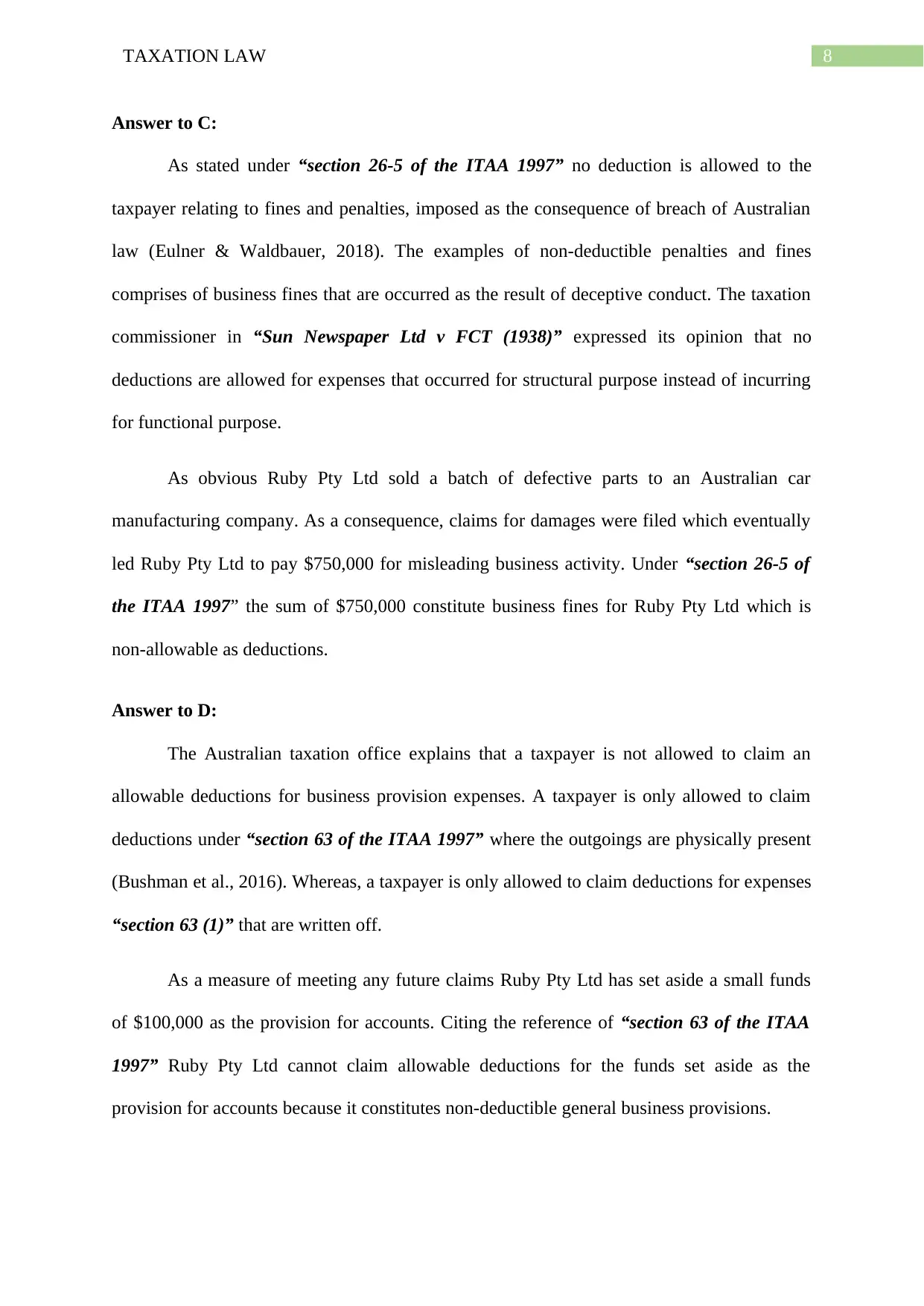
8TAXATION LAW
Answer to C:
As stated under “section 26-5 of the ITAA 1997” no deduction is allowed to the
taxpayer relating to fines and penalties, imposed as the consequence of breach of Australian
law (Eulner & Waldbauer, 2018). The examples of non-deductible penalties and fines
comprises of business fines that are occurred as the result of deceptive conduct. The taxation
commissioner in “Sun Newspaper Ltd v FCT (1938)” expressed its opinion that no
deductions are allowed for expenses that occurred for structural purpose instead of incurring
for functional purpose.
As obvious Ruby Pty Ltd sold a batch of defective parts to an Australian car
manufacturing company. As a consequence, claims for damages were filed which eventually
led Ruby Pty Ltd to pay $750,000 for misleading business activity. Under “section 26-5 of
the ITAA 1997” the sum of $750,000 constitute business fines for Ruby Pty Ltd which is
non-allowable as deductions.
Answer to D:
The Australian taxation office explains that a taxpayer is not allowed to claim an
allowable deductions for business provision expenses. A taxpayer is only allowed to claim
deductions under “section 63 of the ITAA 1997” where the outgoings are physically present
(Bushman et al., 2016). Whereas, a taxpayer is only allowed to claim deductions for expenses
“section 63 (1)” that are written off.
As a measure of meeting any future claims Ruby Pty Ltd has set aside a small funds
of $100,000 as the provision for accounts. Citing the reference of “section 63 of the ITAA
1997” Ruby Pty Ltd cannot claim allowable deductions for the funds set aside as the
provision for accounts because it constitutes non-deductible general business provisions.
Answer to C:
As stated under “section 26-5 of the ITAA 1997” no deduction is allowed to the
taxpayer relating to fines and penalties, imposed as the consequence of breach of Australian
law (Eulner & Waldbauer, 2018). The examples of non-deductible penalties and fines
comprises of business fines that are occurred as the result of deceptive conduct. The taxation
commissioner in “Sun Newspaper Ltd v FCT (1938)” expressed its opinion that no
deductions are allowed for expenses that occurred for structural purpose instead of incurring
for functional purpose.
As obvious Ruby Pty Ltd sold a batch of defective parts to an Australian car
manufacturing company. As a consequence, claims for damages were filed which eventually
led Ruby Pty Ltd to pay $750,000 for misleading business activity. Under “section 26-5 of
the ITAA 1997” the sum of $750,000 constitute business fines for Ruby Pty Ltd which is
non-allowable as deductions.
Answer to D:
The Australian taxation office explains that a taxpayer is not allowed to claim an
allowable deductions for business provision expenses. A taxpayer is only allowed to claim
deductions under “section 63 of the ITAA 1997” where the outgoings are physically present
(Bushman et al., 2016). Whereas, a taxpayer is only allowed to claim deductions for expenses
“section 63 (1)” that are written off.
As a measure of meeting any future claims Ruby Pty Ltd has set aside a small funds
of $100,000 as the provision for accounts. Citing the reference of “section 63 of the ITAA
1997” Ruby Pty Ltd cannot claim allowable deductions for the funds set aside as the
provision for accounts because it constitutes non-deductible general business provisions.
⊘ This is a preview!⊘
Do you want full access?
Subscribe today to unlock all pages.

Trusted by 1+ million students worldwide
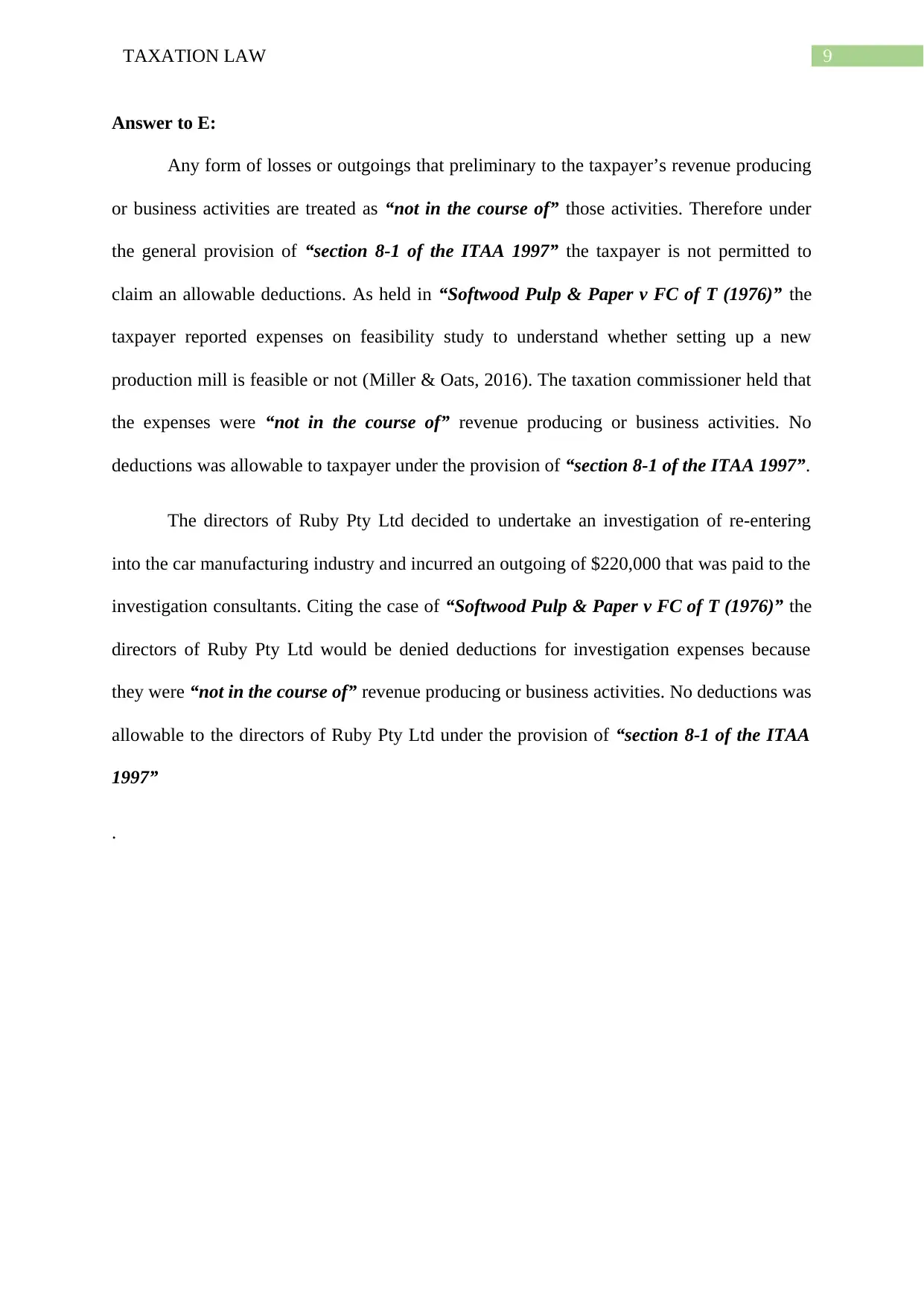
9TAXATION LAW
Answer to E:
Any form of losses or outgoings that preliminary to the taxpayer’s revenue producing
or business activities are treated as “not in the course of” those activities. Therefore under
the general provision of “section 8-1 of the ITAA 1997” the taxpayer is not permitted to
claim an allowable deductions. As held in “Softwood Pulp & Paper v FC of T (1976)” the
taxpayer reported expenses on feasibility study to understand whether setting up a new
production mill is feasible or not (Miller & Oats, 2016). The taxation commissioner held that
the expenses were “not in the course of” revenue producing or business activities. No
deductions was allowable to taxpayer under the provision of “section 8-1 of the ITAA 1997”.
The directors of Ruby Pty Ltd decided to undertake an investigation of re-entering
into the car manufacturing industry and incurred an outgoing of $220,000 that was paid to the
investigation consultants. Citing the case of “Softwood Pulp & Paper v FC of T (1976)” the
directors of Ruby Pty Ltd would be denied deductions for investigation expenses because
they were “not in the course of” revenue producing or business activities. No deductions was
allowable to the directors of Ruby Pty Ltd under the provision of “section 8-1 of the ITAA
1997”
.
Answer to E:
Any form of losses or outgoings that preliminary to the taxpayer’s revenue producing
or business activities are treated as “not in the course of” those activities. Therefore under
the general provision of “section 8-1 of the ITAA 1997” the taxpayer is not permitted to
claim an allowable deductions. As held in “Softwood Pulp & Paper v FC of T (1976)” the
taxpayer reported expenses on feasibility study to understand whether setting up a new
production mill is feasible or not (Miller & Oats, 2016). The taxation commissioner held that
the expenses were “not in the course of” revenue producing or business activities. No
deductions was allowable to taxpayer under the provision of “section 8-1 of the ITAA 1997”.
The directors of Ruby Pty Ltd decided to undertake an investigation of re-entering
into the car manufacturing industry and incurred an outgoing of $220,000 that was paid to the
investigation consultants. Citing the case of “Softwood Pulp & Paper v FC of T (1976)” the
directors of Ruby Pty Ltd would be denied deductions for investigation expenses because
they were “not in the course of” revenue producing or business activities. No deductions was
allowable to the directors of Ruby Pty Ltd under the provision of “section 8-1 of the ITAA
1997”
.
Paraphrase This Document
Need a fresh take? Get an instant paraphrase of this document with our AI Paraphraser
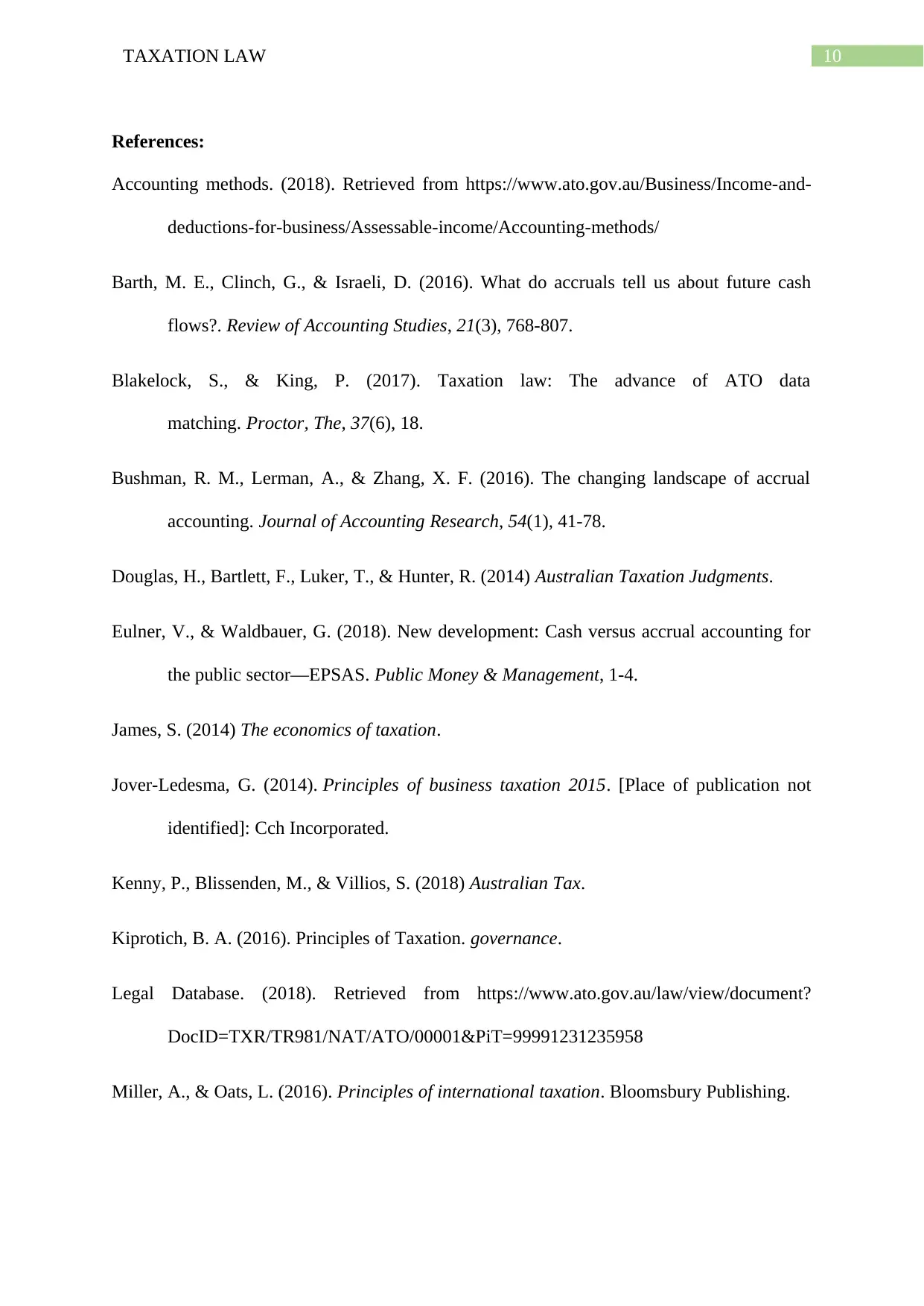
10TAXATION LAW
References:
Accounting methods. (2018). Retrieved from https://www.ato.gov.au/Business/Income-and-
deductions-for-business/Assessable-income/Accounting-methods/
Barth, M. E., Clinch, G., & Israeli, D. (2016). What do accruals tell us about future cash
flows?. Review of Accounting Studies, 21(3), 768-807.
Blakelock, S., & King, P. (2017). Taxation law: The advance of ATO data
matching. Proctor, The, 37(6), 18.
Bushman, R. M., Lerman, A., & Zhang, X. F. (2016). The changing landscape of accrual
accounting. Journal of Accounting Research, 54(1), 41-78.
Douglas, H., Bartlett, F., Luker, T., & Hunter, R. (2014) Australian Taxation Judgments.
Eulner, V., & Waldbauer, G. (2018). New development: Cash versus accrual accounting for
the public sector—EPSAS. Public Money & Management, 1-4.
James, S. (2014) The economics of taxation.
Jover-Ledesma, G. (2014). Principles of business taxation 2015. [Place of publication not
identified]: Cch Incorporated.
Kenny, P., Blissenden, M., & Villios, S. (2018) Australian Tax.
Kiprotich, B. A. (2016). Principles of Taxation. governance.
Legal Database. (2018). Retrieved from https://www.ato.gov.au/law/view/document?
DocID=TXR/TR981/NAT/ATO/00001&PiT=99991231235958
Miller, A., & Oats, L. (2016). Principles of international taxation. Bloomsbury Publishing.
References:
Accounting methods. (2018). Retrieved from https://www.ato.gov.au/Business/Income-and-
deductions-for-business/Assessable-income/Accounting-methods/
Barth, M. E., Clinch, G., & Israeli, D. (2016). What do accruals tell us about future cash
flows?. Review of Accounting Studies, 21(3), 768-807.
Blakelock, S., & King, P. (2017). Taxation law: The advance of ATO data
matching. Proctor, The, 37(6), 18.
Bushman, R. M., Lerman, A., & Zhang, X. F. (2016). The changing landscape of accrual
accounting. Journal of Accounting Research, 54(1), 41-78.
Douglas, H., Bartlett, F., Luker, T., & Hunter, R. (2014) Australian Taxation Judgments.
Eulner, V., & Waldbauer, G. (2018). New development: Cash versus accrual accounting for
the public sector—EPSAS. Public Money & Management, 1-4.
James, S. (2014) The economics of taxation.
Jover-Ledesma, G. (2014). Principles of business taxation 2015. [Place of publication not
identified]: Cch Incorporated.
Kenny, P., Blissenden, M., & Villios, S. (2018) Australian Tax.
Kiprotich, B. A. (2016). Principles of Taxation. governance.
Legal Database. (2018). Retrieved from https://www.ato.gov.au/law/view/document?
DocID=TXR/TR981/NAT/ATO/00001&PiT=99991231235958
Miller, A., & Oats, L. (2016). Principles of international taxation. Bloomsbury Publishing.
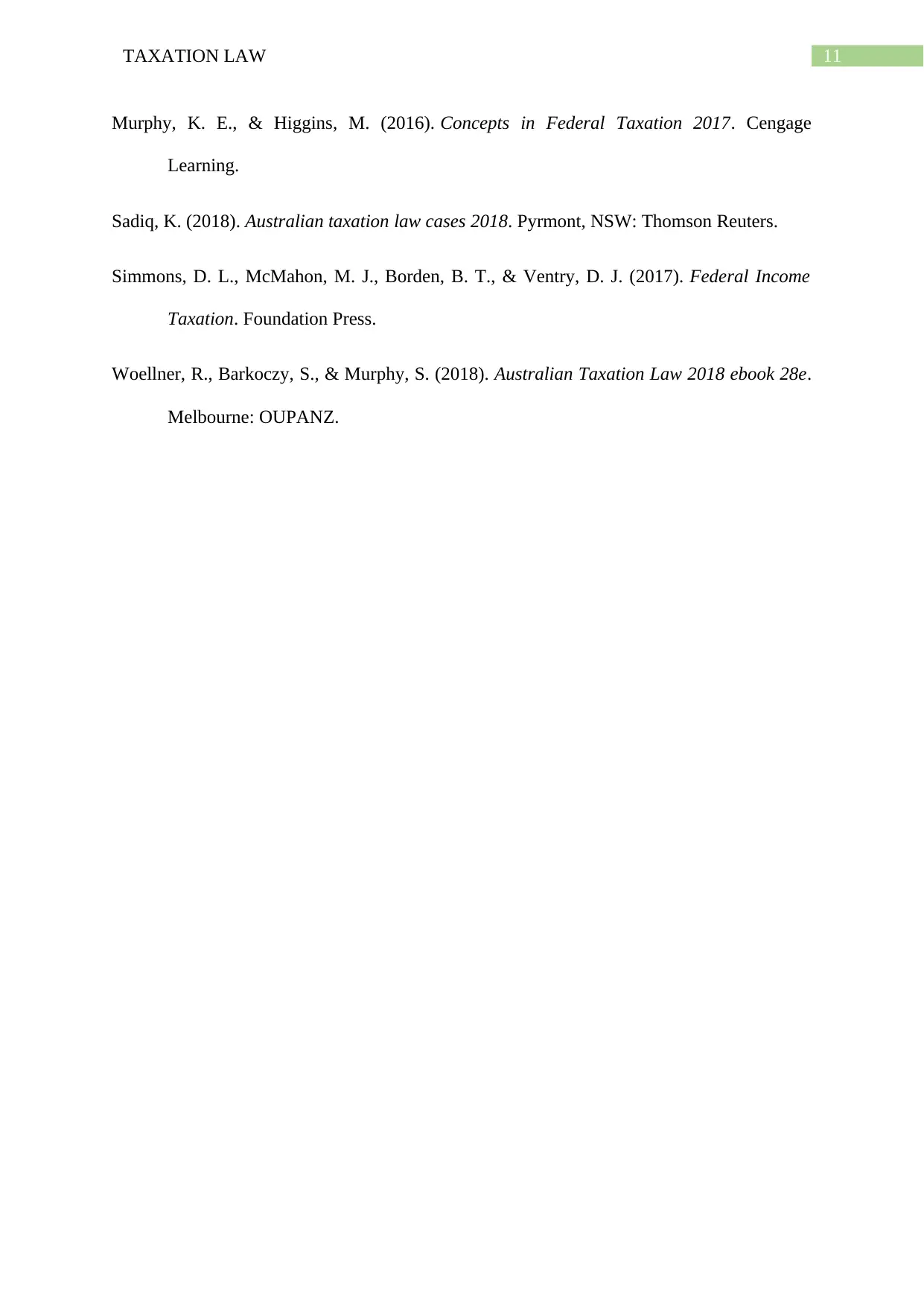
11TAXATION LAW
Murphy, K. E., & Higgins, M. (2016). Concepts in Federal Taxation 2017. Cengage
Learning.
Sadiq, K. (2018). Australian taxation law cases 2018. Pyrmont, NSW: Thomson Reuters.
Simmons, D. L., McMahon, M. J., Borden, B. T., & Ventry, D. J. (2017). Federal Income
Taxation. Foundation Press.
Woellner, R., Barkoczy, S., & Murphy, S. (2018). Australian Taxation Law 2018 ebook 28e.
Melbourne: OUPANZ.
Murphy, K. E., & Higgins, M. (2016). Concepts in Federal Taxation 2017. Cengage
Learning.
Sadiq, K. (2018). Australian taxation law cases 2018. Pyrmont, NSW: Thomson Reuters.
Simmons, D. L., McMahon, M. J., Borden, B. T., & Ventry, D. J. (2017). Federal Income
Taxation. Foundation Press.
Woellner, R., Barkoczy, S., & Murphy, S. (2018). Australian Taxation Law 2018 ebook 28e.
Melbourne: OUPANZ.
⊘ This is a preview!⊘
Do you want full access?
Subscribe today to unlock all pages.

Trusted by 1+ million students worldwide
1 out of 12
Related Documents
Your All-in-One AI-Powered Toolkit for Academic Success.
+13062052269
info@desklib.com
Available 24*7 on WhatsApp / Email
![[object Object]](/_next/static/media/star-bottom.7253800d.svg)
Unlock your academic potential
Copyright © 2020–2025 A2Z Services. All Rights Reserved. Developed and managed by ZUCOL.



